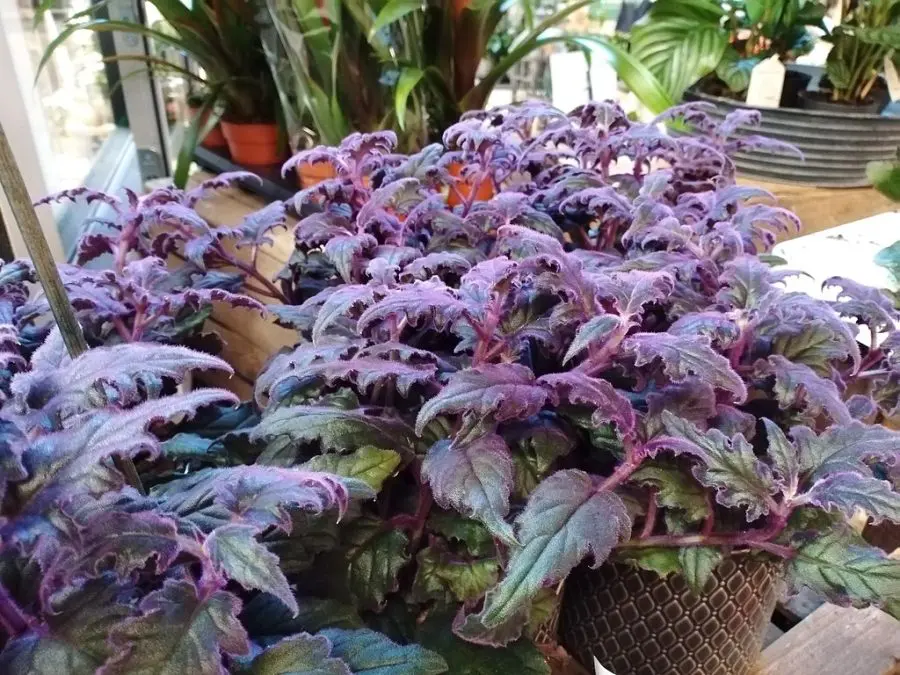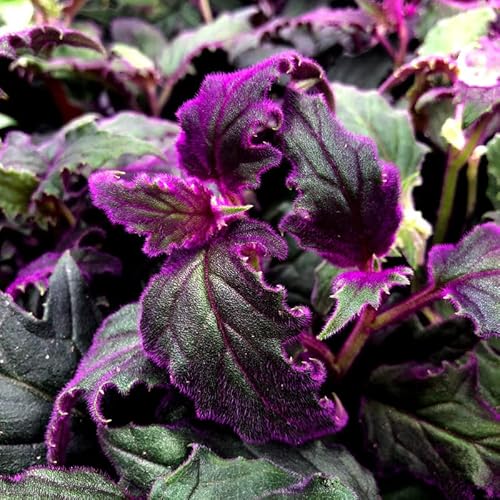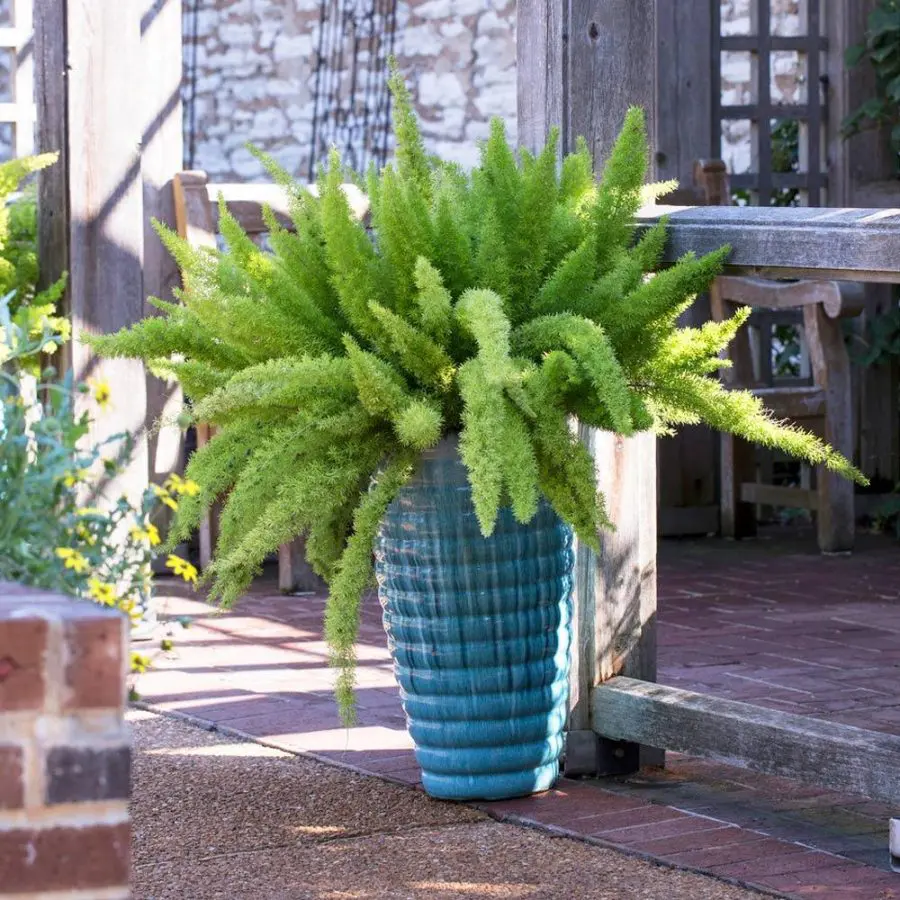This post contains affiliate links. If you buy something from one of our links we may earn a commission. Thanks

Discover the secrets of keeping your Purple Velvet Plant aka Gynura aurantiaca thriving with our easy-to-follow care guide!
Say hello to healthy and vibrant foliage with Purple Velvet Plant Care.
To care for Purple Velvet Plant or Gynura aurantiaca, place it in bright, indirect light and keep the soil consistently moist. This plant thrives in high humidity, so consider misting it or placing it on a pebble tray. Fertilize every 4-6 weeks with a balanced liquid fertilizer during the growing season.
Are you looking to add a touch of exotic flair to your indoor garden? Look no further than the Gynura aurantiaca, also known as the Purple Velvet Plant.
This plant also goes by another common name Purple Passion Plant.
With its unique velvety texture and stunning purple foliage, this plant is sure to turn heads.
But don’t let its beauty fool you – proper Purple Velvet Plant Care is crucial to keeping it healthy and thriving.
In this guide, we’ll walk you through everything you need to know to give your Purple Velvet the care it deserves. Let’s get started!
Purple Velvet Plant Care
Hello plant lovers! Whether you’re a seasoned gardener or just starting out, there’s something magical about bringing a new plant into your home.
And today, I want to share with you one of my personal favorites, the Purple Velvet Plant (or Gynura aurantiaca, if you want to sound fancy).
With its unique purple foliage and soft, velvety texture, this plant is a true work of art.
But as with any living thing, proper care is key to keeping it healthy and vibrant.
So, let’s roll up our sleeves and dive into the wonderful world of Purple Velvet Plant care!
What Is The Purple Velvet Plant?
The Purple Velvet Plant, also known as Gynura aurantiaca, is a unique plant that is sure to add a pop of color to any room.
Its leaves are a rich, velvety purple, and they are known for being soft and fuzzy to the touch.
This plant is native to Southeast Asia, and it loves warm, humid environments.
It’s important to note that the Purple Velvet Plant is toxic to pets, so make sure to keep it out of reach of your furry friends.
According to Wikipedia: Gynura aurantiaca, called purple passion or velvet plant, is a species of flowering plant in the daisy family Asteraceae. It is native to Southeast Asia but grown in many other places as a house plant. In warm regions, it is frequently grown outdoors on patios and in gardens rather than inside buildings
Why Purple Velvet Plant Care is Important
Caring for the Purple Velvet Plant is important for a number of reasons. For one, it helps the plant stay healthy and vibrant, which in turn makes your home look more beautiful.
Additionally, giving your plant proper care can help prevent common issues like wilting, yellowing leaves, or pests.
Lastly, taking care of your plant is a great way to destress and take a break from the chaos of everyday life.
Now that we’ve covered the basics, let’s move on to the specifics of Purple Velvet Plant care.
Purple Velvet Plant Care Requirements
Let’s get down to the nitty-gritty of caring for your Purple Velvet Plant or if you prefer Purple Passion Plant!
To keep your plant thriving, there are a few key areas you’ll need to focus on.
First up, we have velvet plant care requirements. These include things like the amount of light your plant needs, how much water it requires, what type of soil it prefers, and the ideal temperature and humidity levels for your plant.
By paying attention to these key factors, you’ll be well on your way to having a healthy, happy Purple Velvet Plant. So, let’s dive in!
Purple Passion Plant Care Requirements
Light Requirements
The Purple Velvet Plant needs a moderate amount of light to thrive. Ideally, it should be placed in a bright, sunny spot in your home, but out of direct sunlight.
If your plant doesn’t get enough light, its leaves may start to yellow or droop.
On the other hand, if it gets too much direct sunlight, the leaves may become scorched.
So, find a happy medium and aim for 4-6 hours of indirect sunlight per day.
Watering Requirements
When it comes to watering your Purple Velvet Plant, less is often more. Overwatering can cause the roots to rot and can lead to a variety of issues like yellowing leaves or fungus growth.
Aim to water your plant every 7-10 days, or when the top inch of soil feels dry to the touch.
You may need to adjust this based on the humidity levels in your home. If your plant is in a drier environment, you may need to water it more frequently.
Purple Passion Soil Requirements
The Purple Velvet Plant prefers a well-draining soil mix that is rich in organic matter.
You can use a standard potting mix and add in some perlite or sand to increase drainage.
It’s important to fertilize your plant every 4-6 weeks during the growing season (spring and summer), but avoid fertilizing during the dormant season (fall and winter).
Temperature and Humidity Requirements
The ideal temperature range for the Purple Velvet Plant is between 60-80°F (15-27°C).
It can tolerate slightly cooler temperatures but avoid placing it in a drafty area.
Additionally, this plant thrives in humid environments.
If your home is dry, you can increase the humidity levels around your plant by placing a tray of water nearby or using a humidifier.
Purple Passion Plant Propagation
Alright, we’ve covered the basics of taking care of your Purple Velvet Plant.
But what if you want to grow even more of these beautiful plants?
That’s where plant propagation comes in! Propagation is the process of creating new plants from an existing one.
It’s a great way to expand your plant collection or share your love of gardening with friends and family.
Plus, it’s a fun and rewarding experience to watch your plant grow from a tiny cutting to a full-grown plant. So, let’s dive into the world of Purple Velvet Plant propagation!
How to Propagate the Purple Velvet Plant
There are two main methods for propagating the Purple Velvet Plant: stem cuttings and division.
Stem cuttings involve taking a cutting from a healthy plant and rooting it in water or soil until it grows into a new plant.
Division involves separating a plant into smaller sections and potting them separately.
Both methods can be effective, but stem cuttings are generally the easiest and most common way to propagate the Purple Velvet Plant.
Taking Stem Cuttings Step-by-Step Instructions
To propagate your Purple Velvet Plant using stem cuttings, follow these steps:
• Choose a healthy plant with several stems and leaves.
• Use a sharp, clean pair of scissors or garden shears to cut a stem that is at least 4-6 inches long. Make sure the stem has several leaves and is not flowering.
• Remove the lower leaves from the stem, leaving only 2-3 leaves at the top.
• Dip the cut end of the stem in rooting hormone (optional).
• Place the stem in a container filled with water or well-draining soil.
• If rooting in water, change the water every few days to prevent bacterial growth.
• If rooting in soil, keep the soil moist but not waterlogged.
• After a few weeks, you should see new roots starting to grow.
• Once the roots are at least 1-2 inches long, you can transplant the new plant into a larger pot with well-draining soil.
By following these simple steps, you can propagate your own Purple Velvet Plants and share them with others!
Common Purple Velvet Plant Care Problems
As much as we love our plants, sometimes things don’t always go according to plan.
Even with the best care, the Purple Velvet Plant can experience some common problems like pests, diseases, and environmental stress.
But don’t worry because with a little bit of knowledge and some simple solutions, you can keep your plant healthy and thriving.
In this section, we’ll explore some of the most common problems that can affect your Purple Velvet Plant and how to solve them.
Purple Velvet Plant Care Common Problems
Despite its hardiness, the Purple Velvet Plant can still experience some common problems. Here are a few to watch out for:
• Spider mites: These tiny pests can cause yellowing leaves, webbing, and overall decline in the plant’s health.
• Mealybugs: These soft, white bugs can gather in crevices of the plant and suck the sap from the leaves and stems.
• Root rot: Overwatering or poorly draining soil can lead to root rot, which can cause the plant to wilt and its leaves to turn yellow or brown.
Purple Velvet Plant Care Solutions
Luckily, there are some simple solutions. Here are a few to try:
• Spider mites: To get rid of spider mites, you can spray the plant with insecticidal soap or neem oil. Be sure to also isolate the plant from others until the problem is resolved.
• Mealybugs: Mealybugs can be removed with a cotton swab dipped in rubbing alcohol or neem oil. You can also spray the plant with a solution of water and dish soap.
• Root rot: If you suspect root rot, remove the plant from its pot and inspect the roots. If they are brown and mushy, trim away the affected areas and repot the plant in fresh, well-draining soil.
By staying vigilant and addressing problems as soon as they arise, you can keep your Purple Velvet Plant healthy and happy for years to come.
Purple Passion Plant Orange Flowers And Unpleasant Smell
One interesting feature of the Purple Velvet Plant is its small, orange flowers that bloom periodically.
While these flowers are not the main attraction of the plant, they can add a pop of color to your space.
However, it’s worth noting that the Purple Velvet Plant is not typically grown for its flowers.
Another thing to note about the Purple Velvet Plant is that it has a distinctive odor.
Some people describe the smell as unpleasant or even offensive, while others don’t notice it at all.
If you’re sensitive to smells, it may be worth considering whether the Purple Velvet Plant is the right choice for your home.
Of course, if you like the plant I don’t see why you can’t just pinch off any flowers it makes. It is not a heavy flower producer.
Purple Velvet Plant Care Lifespan
With proper care, the Purple Velvet Plant can live for several years.
However, like all plants, its lifespan can be influenced by a variety of factors, including environmental conditions and the health of the plant.
It’s not uncommon for the Purple Velvet Plant to start looking a bit scrappy after a few years, but with a bit of pruning and care, it can continue to thrive for years to come.
Since it is easy to propagate you may want to consider making new replacement plants every few years.
Purple Velvet Plant FAQs
When it comes to caring for a Purple Velvet Plant, also known as Purple Passion or Gynura aurantiaca, there are several important considerations that come into play.
From its sunlight requirements to its compatibility with pets, this unique houseplant has its own set of needs.
Here, we answer some of the most frequently asked questions to guide you through the care process.
Q: Does Purple Passion like sun or shade?
A: Purple Passion prefers bright, indirect light. Too much direct sunlight can bleach its vibrant foliage, while too little light can result in weak, leggy growth.
Q: Is purple passion plant poisonous?
A: The Purple Passion plant is not considered poisonous to humans, but ingestion can cause mild gastrointestinal upset.
Q: Is Gynura toxic to cats?
A: There is limited information available on the toxicity of Gynura to cats. However, as a general precaution, it’s best to keep it out of reach of pets.
Q: How do I make my purple passion plant happy?
A: Keep the plant in a bright location but avoid direct sunlight.
The soil should be consistently moist, and the plant enjoys high humidity.
You can also feed it with a balanced liquid fertilizer every 4-6 weeks during the growing season.
Q: Should I mist my purple passion plant?
A: Yes, misting your Purple Passion plant can help maintain the high humidity levels it thrives in.
You can also place it on a pebble tray with water to increase humidity around the plant.
Purple Velvet Plant Care Final Thoughts
In conclusion, the Purple Velvet Plant (Gynura aurantiaca) is a beautiful and unique plant that can add a touch of elegance to any space.
With its soft, velvety leaves and striking purple color, it’s easy to see why this plant has become so popular in recent years.
While it does require some specific care, including proper light and water conditions, it can be a rewarding plant to grow for both novice and experienced plant owners alike.
By following the tips and tricks outlined in this guide, you can enjoy a healthy and thriving Purple Velvet Plant for years to come.
Recap
In this post, we’ve covered everything you need to know about caring for a Purple Velvet Plant.
We’ve discussed the plant’s characteristics and why it’s important to care for it properly.
We’ve also covered its light, water, soil, temperature, and humidity requirements, as well as how to propagate the plant and deal with any common problems that may arise.
Finally, we’ve talked about the plant’s lifespan and its distinctive orange flowers and unpleasant odor.
Why not give Purple Velvet Plant Care A Try
We hope that this guide has provided you with all the information you need to successfully care for your own Purple Velvet Plant.
While it may seem intimidating at first, caring for plants can be a deeply rewarding experience that brings joy and beauty to your home.
So why not give Purple Velvet plant care a try? With a bit of care and patience, you too can enjoy the lush, velvety foliage of the Purple Velvet Plant in your own space.
Read more about the benefits of keeping indoor plants














